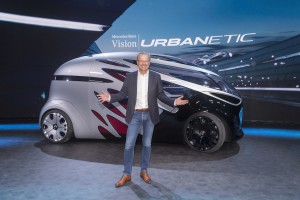
Mercedes-Benz unveiled its Vision Urbanetic concept. Shown here as a people mover, it's the company's take on future mobility.
Mercedes-Benz looked into the future to find ways to move people and things efficiently and quietly around cities and developed the Vision Urbanetic concept, which uses an electric powertrain and configurable bodies to do exactly that.
The result is a self-driving, electrically powered chassis that can take different switchable bodies for people moving or goods transport. As a ride-sharing vehicle, Vision Urbanetic can accommodate up to 12 passengers, while the cargo module can carry up to ten EPAL pallets.
The interior cargo space is about 12.5 feet long while the entire vehicle is nearly 17 feet long. The vehicle can be incorporated into an IT infrastructure that analyzes in real time the supply and demand within a defined area.
These capabilities result is a self-driving fleet with route flexibility and efficiency because it uses real-time data to make route adjustments. These characteristics mean a virtual end to traffic jams and other congestion, according to Mercedes.
(Mercedes previews new all-electric EQ line with test drive of Concept EQA. Click Here for more.)
The key to the Vision Urbanetic is the interchangeable bodies. When the Urbanetic is outfitted as a people mover, it can handle 12 passengers. As a cargo hauler, it can handle 10 EPAL palettes or volume of 10 cubic meters. Switching is quick and easy, according to Mercedes, taking just a few minutes to convert.
Each version sits on a mobile platform, similar to the skateboard design, which is used for the base of many other vehicles and concepts. It incorporates all of the driving functions, including the autonomous technology to need to get around in an urban area.
As has been demonstrated recently, not all autonomous vehicles are foolproof in terms of avoiding collisions, but Mercedes has gone the extra mile with the Urbanetic with redundant components for all relevant actions such as steering, braking and acceleration.
(Click Here for more about Daimler’s restructuring plans.)
The vehicle uses multiple cameras and sensor systems to observe its surroundings in their entirety and communicates actively with them. It uses the large-format display on the front of the vehicle to inform pedestrians crossing the street in front of it that it has noticed them.
Another highlight is digital shadowing around the side door. Several hundred light units display the contours of approaching individuals along the flanks, signaling to them that the Vision Urbanetic has noticed them.
The system architecture of the autonomous Vision Urbanetic changes to more efficient routs using real-time traffic information. The operator’s fleet management is also part of the IT system, with usage conceivable in restricted areas such as a factory site or airport as well as in road traffic.
(To see more about Mercedes new Sprinter plant in South Carolina, Click Here.)
Vision Urbanetic’s electric drive delivers zero-local-emissions mobility, thus making it the perfect vehicle for city centers and areas subject to legal access restrictions. The virtually noiseless electric drive also presents new options for late or night-time deliveries and thus offers major commercial potential.
